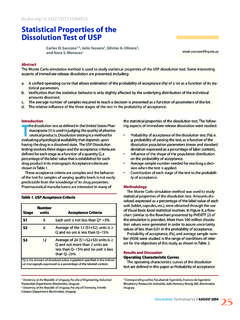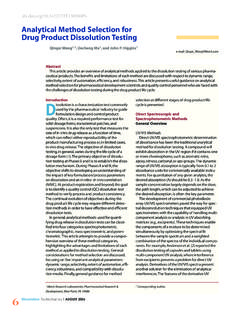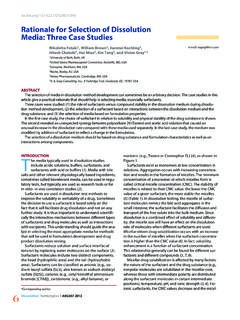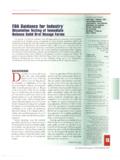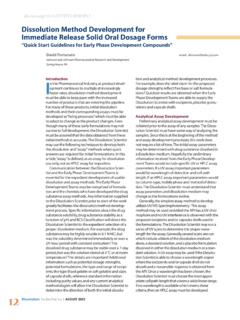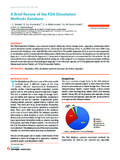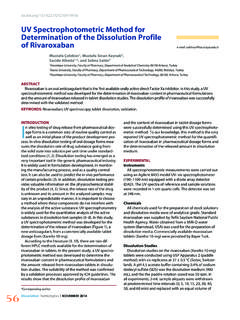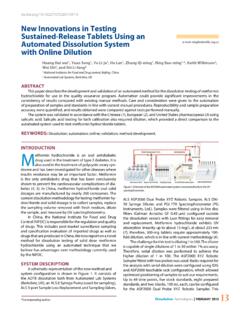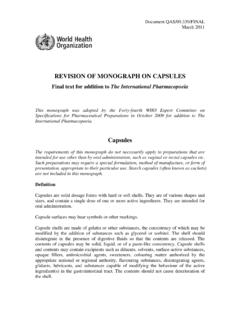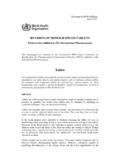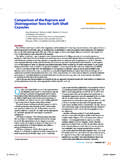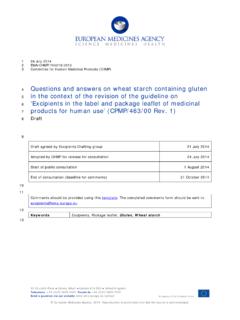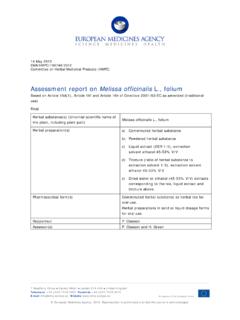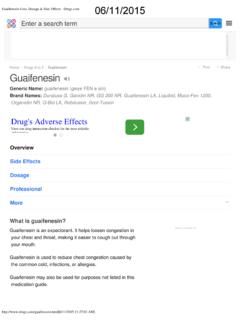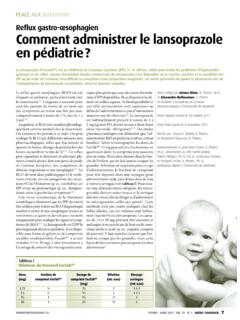Transcription of Use of Enzymes in the Dissolution Testing of Gelatin ...
1 6 Dissolution Technologies | NOVEMBER 2014 STIMULI TO THE REVISION PROCESS Stimuli articles do not necessarily reflect the policies of the USPC or the USP Council of ExpertsUse of Enzymes in the Dissolution Testing of Gelatin Capsules and Gelatin -Coated Tablets revisions to Dissolution <711> and Disintegration and Dissolution of Dietary Supplements <2040>Vivan A. Graya,b, Ewart Colea, Joan M. D. Riva Tomaa, Luigi Ghidorsia, Jian-Hwa Guoa, Jian-Hwa Hana, Feixue Hana, Christopher T. Hostya, Jianmei D. Kochlinga, Johannes Kraemera,b, Thomas Langdona, Steven R. Leinbacha, Gregory P. Martina,b, Steven M. Meyerhoffera, Richard C. Moretona,b, Krishnaswamy , Edward Shneyvasa, Jason A.
2 Suggetta,b, Stephen Tindala, Madhusudan Vudathalaa, Hu Wanga, Om Anandc, Zongming Gaoc, Rakhi Shahc, Li Xiac, Joe Fotsoa, Munir A. Hussaina,b, Vi N. Schmidta, Tapash Ghoshc, Natalia Davydovad, William E. Brownd, Jeanne M. Fringere, Erika S. Stipplerd, Tovmasian Eranuif, and Margareth R. C. Marquesd,g ABSTRACT A revision to the general chapters Dissolution <711> and Disintegration and Dissolution of Dietary Supplements <2040> is being proposed to address the shortcomings of the current chapters regarding the use of Enzymes in the Dissolution test of Gelatin capsules or Gelatin -coated tablets. The recommendations are to use the Enzymes pepsin (medium with pH equal to or below ), papain or bromelain (medium with pH above and below ), and pancreatin (medium with pH equal to or above ) if the dosage form does not comply to the appropriate Acceptance Table or, in the case of dietary supplements, appropriate Tolerances requirements due to the presence of cross-linking in the Gelatin .
3 Also, the revision clarifies how the en-zyme activity should be determined, the amount of Enzymes to be added to the medium, and a pre-treatment procedure to be used when the Dissolution medium contains surfactant or any other ingredient known or suspect to inactivate the enzyme be-ing used. This Stimuli article provides the rationale for these revisions and presents data to support the recommendations being made. Readers are encouraged to send any comments, questions, suggestions or data to the corresponding author. Also, see the section Other Related revisions at the end of this article for information on other related general chapters and The USP general chapters Dissolution <711> (1) and Disintegration and Dissolution of Dietary Supple-ments <2040> (2) allow the addition of Enzymes to the Dissolution medium when hard or soft Gelatin cap-sules and Gelatin -coated tablets do not conform to the Dissolution specification.
4 The current text in these chapters is: For hard or soft Gelatin capsules and Gelatin -coated tablets that do not conform to the Dissolution specification, repeat the test as follows. Where water or a medium with a pH of less than is specified as the Medium in the individual monograph, the same Medium specified may be used with the addition of purified pepsin that results in an activity of 750,000 Units or less per 1000 mL. For media with a pH of or greater, pancreatin can be added to produce not more than 1750 USP Units of protease activity per 1000 instructions present some challenges: 1) The text that do not conform to the Dissolution speci-fication is open for interpretation because it does not exclusively relate the Dissolution failure to the presence of cross-linking in the Gelatin .
5 The user can assume that the Enzymes can be used for any type of failure, even those not related to Gelatin cross-linking. Also, there is no clear definition of what constitutes the Dissolution a USP Expert Panel. b USP Expert Committee. c Food and Drug Administration (FDA) liaison to USP Expert Panel and/or USP Expert Committee. The views presented in this article do not necessarily reflect those of the FDA. No official support or endorsement by the FDA is intended or should be inferred. d USP Scientific Liaison. e USP Scientist, Biologics and Biotechnology Laboratory. f Scientific secretary to the Ukrainian Scientific Pharmacopoeial Center for Quality of Medicines.
6 G Correspondence should be addressed to Margareth R. C. Marques, , Principal Scientific Liaison, USP, 12601 Twinbrook Parkway, Rockville, MD 20852-1790; phone 301 816 8106, e-mail with permission. Copyright 2014. The United States Pharmacopeial Convention. All rights reserved. Dissolution Technologies | NOVEMBER ) The chapter recommends the use of pepsin when the medium is water or it has a pH less than The pH for optimal activity of pepsin is up to a pH of 4; pepsin has almost no protease activity above pH (3).3) The use of purified pepsin is recommended. The speci-fication for this enzyme is in the Reagent Specifications section of USP NF (4). Not all users are aware that this specification contains the procedure for determining the appropriate pepsin activity.
7 Commonly, the amount of pepsin to be added to the medium is based on the information displayed on the reagent label or in the certificate of analysis, where the units used may not be comparable or equivalent to those obtained when following the procedure in the purified pepsin specifi-cation in USP ) Pepsin has good activity up to pH 4 and pancreatin is to be used for Dissolution media with pH above , there is no current recommendation for an enzyme appropriate for the pH range from 4 to ) The text does not give any guidance regarding dissolu-tion media that contain surfactant or other ingredients that may denature the enzyme being revision to <711> and <2040> is being published in 40(6) issue of Pharmacopeial Forum to address these issues and make recommendations for the appropriate procedures to be followed.
8 This Stimuli article gives the scientific background for these revisions and present data to support the recommendations being made. CROSS LINKING IN Gelatin CAPSULES One of the major factors that can affect the properties of the Gelatin capsule shell is the chemical interactions between the fill material and Gelatin or between the Gelatin and environment during storage, which can result in Gelatin cross-linking. Cross-linking entails the formation of strong chemical linkages beyond simple hydrogen and ionic bonding between Gelatin chains (5 7). One of the strongest and most common types of cross-linking involves the covalent bonding of the amine group of a lysine side chain of one Gelatin molecule to a similar amine group on another Gelatin molecule.
9 This reaction generally is cata-lyzed by trace amounts of reactive aldehydes. Formalde-hyde, glutaraldehyde, glyoxal, and reducing sugars are the most common catalysts. The covalent bonding produced with this type of cross-linking is, for all practical purposes, irreversible, and will eventually render the Gelatin insoluble. When the Gelatin is no longer soluble in water, Dissolution of the shell must involve the breaking of other bonds, , by enzyme-mediated breaking of peptide bonds in protein chains. Common causes of cross-linking include: 1) Aldehydes present in active pharmaceutical ingredi-ents, excipients, packaging materials, or degradants formed in situ during storage ( , polyethylene glycols that may auto-oxidize to form aldehydes) 2) High humidity 3) Substances that facilitate a cross-linking reaction 4) Substances that promote decomposition of stabilizers used in excipients such as hexamethylenetetramine in corn starch resulting in the formation of ammonia and formaldehyde 5) Rayon coilers that contain an aldehyde functional group (furfural) 6) Polyethyelene glycols that may auto-oxidize forming aldehydes 7) UV light, especially in the presence of high temperature and humidity 8)
10 Heat, which can catalyze aldehyde formation Cross-linking typically results in the formation of a pellicle on the internal or external surface of the Gelatin capsule shell that prevents the capsule fill from being released. Cross-linking is evidenced by the observation of a thin membrane or gelatinous mass during Dissolution Testing (8). In vitro Dissolution Testing of cross-linked capsules can result in slower or incomplete release of the active ingre-dient or no release at all (9, 10). The degree of cross-linking is not usually uniform within one capsule or among differ-ent capsules. As consequence, Dissolution results will have higher variability when Gelatin capsules are cross-linked (5, 6, 8, 9, 11).

